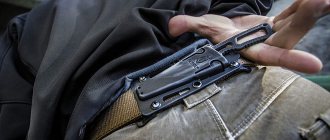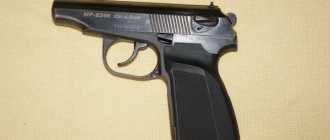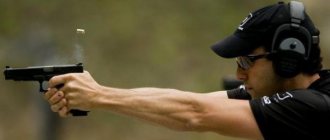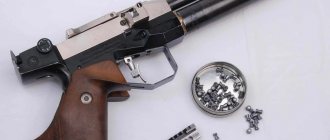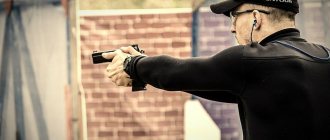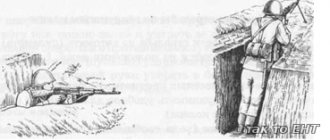Delays when firing a pistol: types of delays, causes and solutions
A pistol, when handled correctly, carefully maintained and preserved, is a reliable and trouble-free weapon. However, during prolonged operation, due to wear and tear of parts and mechanisms, and more often due to careless handling and inattentive maintenance, delays in firing may occur.
To prevent delays when firing a pistol and ensure its safe operation, you must:
- properly prepare a pistol for shooting;
- inspect, clean and lubricate the gun in a timely manner and in compliance with all rules; Take special care to clean and lubricate the rubbing parts of the gun;
- carry out repairs in a timely manner;
- inspect cartridges before shooting;
- Do not use faulty, rusty or dirty cartridges for shooting;
- during shooting and when moving, protect the pistol from contamination and impacts;
- If the pistol is in severe frost for a long time before firing, then before loading it it is necessary to release the bolt several times by hand and release it, and after each retraction and release of the bolt it is necessary to release the trigger by pressing the tail of the trigger.
If there is still a delay during shooting, then it must be eliminated by reloading the pistol (cocking and releasing the bolt frame - editor's note) .
If the delay cannot be eliminated by recharging, then it is necessary to find out the cause of the delay and eliminate it as indicated below.
Types of delays when shooting, causes and ways to eliminate them
| Type of malfunction | Reasons for delays | Ways to eliminate them |
| 1. Misfire. The bolt is in the forward position, the trigger is pulled, but the shot does not fire. | 1. The cartridge primer is faulty. 2. Thickening of the lubricant or contamination of the channel under the firing pin. 3. The output of the striker or nick on the striker is small. | 1. Reload the pistol and continue shooting. 2. Inspect and clean the gun. 3. Poison the gun to the workshop. |
| 2. Failure to cover the cartridge with the bolt. The shutter stopped before reaching the extreme forward position; the trigger cannot be pulled. | 1. Contamination of the chamber, frame grooves, bolt cup. 2. Difficult movement of the ejector due to contamination of the ejector spring or pressure. | 1. Push the bolt forward with a push of your hand and continue shooting. 2. Inspect and clean the gun. |
| 3. Failure to feed or not advance the cartridge from the magazine into the chamber. The bolt is in the forward position, but there is no cartridge in the chamber; the bolt stopped in the middle position along with the cartridge, without sending it into the chamber. | 1. Contamination of the magazine and moving parts of the gun. 2. Bent upper edges of the magazine body. | 1. Reload the pistol and continue shooting. 2. Clean the gun and magazine. 3. Replace the faulty magazine. |
| 4. Seizing (pinching) of the cartridge case by the bolt. The cartridge case was not thrown out through the window in the bolt and became wedged between the bolt and the breech end of the barrel. | 1. Contamination of the moving parts of the gun. | 1. Throw away the stuck cartridge case and continue shooting. 2. Send the gun to the workshop. |
| 5. Automatic shooting. | 1. Thickening of the lubricant or contamination of parts of the trigger mechanism. 2. Wear of the hammer cocking or sear nose. 3. The sear spring is weakened or broken. 4. Touching the shelf of the fuse ledge of the sear tooth. | 1. Inspect and clean the gun. 2. Send the gun to the workshop. |
What safety precautions are taken when shooting various weapons?
- integrated classes (“Physical and environmental education of preschool children: lines of intersection”, “Synthesis of arts in preschool education”, etc.);
- festivals of creativity (intergenerational regional festival of military-patriotic songs and poetry, etc.).
Summarizing the above, it should be noted that in the learning process, each student goes through certain stages of mentoring activities, and can simultaneously be both a mentor and a mentee (for example, third-year students can initiate and conduct a joint event, or senior students who are in practice in preschool educational organizations are mentees).
An indicator for assessing the effectiveness of mentoring is the level of creative activity of mentors and mentees in joint activities to develop projects, non-standard solutions, etc. In addition, the student mentor acquires:
— experience in managing and teaching junior students and peers; takes part in the annual student competition “My Profession”;
— recognition of fellow students, increases one’s own status;
— the opportunity to receive increased scholarships at various levels (university, regional, international), including an indicator of social activity, manifestation of initiative and independence in the educational process;
— certificates, diplomas, gratitude of various levels, characteristics and recommendations for employers and from employers;
— mentoring experience in the volunteer movement;
— the ability to broadcast your mentoring experience in the media;
— qualification in the “School of Young Researchers”, organized at the department.
Conclusions. Over the past four years, 98% of mentees have successfully adapted to the university environment, take an active part in intercourse and interdepartmental interaction, are socialized, professionalized, successfully undergo teaching practice in preschool educational organizations of Veliky Novgorod and the region, annually on average 20% of bachelor's graduates enter master's programs majoring in Educational Management.
Thus, the quality of professional training of a future preschool teacher is ensured not only by the activation of students in mastering the main undergraduate educational program “Preschool Education”, but also to a large extent by the integration of the student mentoring system with the educational environment, which develops the creative activity of students in classroom and extracurricular work, creates a need for constant replenishment and updating of knowledge, improvement of practical skills, consolidation and transformation of their professional competencies.
Literature:
1. Bagdasaryan A.A. Pedagogical experience - mechanisms and conditions of translation in the system of developmental interaction “teacher - mentor - student” // Bulletin of the Sochi State University of Tourism and Resort Business. 2009. No. 4. P. 148-153.
2. Vakhitova G.Kh. Quasi-professional activity in the preparation of future specialists in pre-school education // Vestn. Tomsk State ped. University (TSPU Bulletin). 2016. No. 5 (170). pp. 64-66.
3. Vershlovsky S.G. Teacher-Methodist-Trainee Mentor / S.G.Vershlovsky, T.I.Grib, V.Yu.Krichevsky, etc. M.: Education, 1988. 144 p.
4. Kulyutkin Yu.N., Sukhobskaya G.S. Teacher's thinking. Personal mechanisms and conceptual apparatus. M.: Pedagogika, 1970. 104 p.
5. Nevyantseva N.N. Managing the adaptation process of junior year students: experience, traditions and innovations // Journal of scientific publications “Discussion”. Category: Pedagogical Sciences.” 2016. No. 1 (64).
6. Sukhova O.V., Brezgina M.O. Labor potential of an excellent university graduate within the framework of the implementation of the state strategy for innovative development // Discussion. 2015. No. 10 (62). pp. 75-80.
To comply with the law, a police officer:
- Informs persons who may be shot at that he is a police officer.
- Warns that weapons may be used. A warning shot in the air is allowed. The law does not require this, but many police officers prefer to do it so that during subsequent targeted shooting there will be no complaints against them from the investigative authorities. If police officers act as a group, only one of them (usually the senior in rank) can issue a warning.
- Gives time to comply with the lawful request of the police.
In some cases, a police officer has the right to use firearms immediately, that is, without warning. This is possible if you cannot delay, since there is already a threat to people’s health or lives.
If there is reason to believe that it will be necessary to use a weapon, the policeman has the right to take it out in advance and prepare to shoot, without actually opening fire yet. However, it should be noted that in this case special rules begin to apply.
Since there is a risk that a criminal will try to attack a police officer and take possession of his weapon, an armed police officer who is ready to shoot has the right to demand that the person being detained remain in place. If, after such a demand, the detainee still tries to approach, the police officer has the right to use a firearm.
The use of weapons by police has its limitations:
- A police officer cannot shoot to kill pregnant women, children, teenagers and the disabled. The exception is cases when these persons either resist with weapons in their hands or attack in a group, threatening the life and health of the police officer or other citizens.
- A police officer does not have the right to shoot in a crowd if there is a risk that persons not involved in breaking the law may be hit by the bullet. It should be noted that this rule no longer has exceptions.
The weapon must be in good working order. The shooting range's weapons are regularly checked and maintained according to all rules. And all the necessary cleaning, disassembly, repair and shooting procedures take place in a specially designated place and by specialists. Only a person familiar with safety precautions can use a weapon. Everyone who entered the shooting range listened to the safety precautions, read the instructions and undertakes to comply with all the rules. He is also familiar with the structure of the weapon and the procedure for its operation. Shots and all actions in the shooting range occur only at the command of the instructor. The commands “Load”, “Fire”, “Start”, “End Light”, “Stop” mean their immediate and strict execution. Otherwise, you may be rightfully disqualified from shooting because you pose a danger to others. By default, any weapon is always considered to be loaded. That is, it is assumed that it can fire at any moment. The following automatically follows from this rule - that the weapon is always pointed in a safe direction
.
Or rather, where you don’t plan to shoot. When moving, this is always
the position of the weapon with the barrel up. Full control of the affected area is required. Everything in front of the pistol is considered to be in the danger zone and is constantly monitored. If people appear in this area, the shooting stops immediately. The finger never touches the trigger Until the moment of a controlled shot, the index finger is positioned perpendicular to the trigger, so that it is always clearly visible. It is absolutely forbidden to catch a falling weapon. All modern weapons will not fire from a fall or impact, and trying to catch it, you can provoke a shot. Loaded weapons are also not transferred into the hands of another person.
Of course, these rules are mandatory for all persons at the shooting range, conducting or taking part in training, regardless of level and experience. Skills for safe handling of weapons should work at the level of reflexes, which guarantees complete safety for you and those around you. And the listed rules themselves were written by the International Practical Shooting Confederation (IPSC) and are called the Shooter’s Code.

